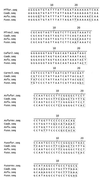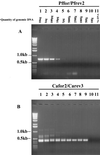Rapid detection and identification of Candida, Aspergillus, and Fusarium species in ocular samples using nested PCR
- PMID: 10921948
- PMCID: PMC87142
- DOI: 10.1128/JCM.38.8.2902-2908.2000
Rapid detection and identification of Candida, Aspergillus, and Fusarium species in ocular samples using nested PCR
Abstract
A protocol for the rapid detection of fungal DNA in ocular samples, derived from three species, Candida albicans, Aspergillus fumigatus, and Fusarium solani, has been developed. Two novel panfungal primers complementary to 18S rRNA sequences present in all three species were designed. Panfungal PCR was followed by three nested PCRs utilizing species-specific primers. PCR sensitivity ranged from 50 to 100 fg of free DNA and between one and two C. albicans organisms. In addition, we also developed a rapid and reliable DNA extraction protocol. This protocol minimized DNA loss during extraction, whilst removing compounds from vitreous and aqueous fluids that have previously been shown to have inhibitory effects on PCR. Preliminary results obtained after testing the protocol on three patient samples support culture results and medical history. However, one patient was PCR positive but culture negative, suggesting that the sensitivity of this protocol may exceed that of traditional culture techniques. This system, therefore, constitutes an additional protocol that may significantly aid patient management in cases where fungal endophthalmitis is suspected.
Figures






Similar articles
-
Detection of Candida and Aspergillus species DNA using broad-range real-time PCR for fungal endophthalmitis.Graefes Arch Clin Exp Ophthalmol. 2012 Mar;250(3):391-8. doi: 10.1007/s00417-011-1819-1. Epub 2011 Sep 27. Graefes Arch Clin Exp Ophthalmol. 2012. PMID: 21947326
-
Polymerase chain reaction and restriction fragment length polymorphism mediated detection and speciation of Candida spp causing intraocular infection.Invest Ophthalmol Vis Sci. 1998 May;39(6):859-66. Invest Ophthalmol Vis Sci. 1998. PMID: 9579465
-
Monochrome LightCycler PCR assay for detection and quantification of five common species of Candida and Aspergillus.J Med Microbiol. 2005 Mar;54(Pt 3):243-248. doi: 10.1099/jmm.0.45856-0. J Med Microbiol. 2005. PMID: 15713607
-
Fungal endophthalmitis.Expert Rev Anti Infect Ther. 2011 Dec;9(12):1191-201. doi: 10.1586/eri.11.139. Expert Rev Anti Infect Ther. 2011. PMID: 22114969 Review.
-
Use of PCR in endophthalmitis.Ocul Immunol Inflamm. 2000 Sep;8(3):189-200. Ocul Immunol Inflamm. 2000. PMID: 11120580 Review.
Cited by
-
Endophthalmitis: Pathogenesis, clinical presentation, management, and perspectives.Clin Ophthalmol. 2010 Mar 24;4:121-35. doi: 10.2147/opth.s6461. Clin Ophthalmol. 2010. PMID: 20390032 Free PMC article.
-
SARS-CoV-2 and Aspergillus section Fumigati coinfection in an immunocompetent patient treated with corticosteroids.Rev Iberoam Micol. 2021 Jan-Mar;38(1):16-18. doi: 10.1016/j.riam.2020.11.001. Epub 2020 Nov 28. Rev Iberoam Micol. 2021. PMID: 33500209 Free PMC article.
-
Rapid Isolation and Concentration of Pathogenic Fungi Using Inertial Focusing on a Chip-Based Platform.Front Cell Infect Microbiol. 2019 Feb 12;9:27. doi: 10.3389/fcimb.2019.00027. eCollection 2019. Front Cell Infect Microbiol. 2019. PMID: 30809512 Free PMC article.
-
Current perspectives on ophthalmic mycoses.Clin Microbiol Rev. 2003 Oct;16(4):730-97. doi: 10.1128/CMR.16.4.730-797.2003. Clin Microbiol Rev. 2003. PMID: 14557297 Free PMC article. Review.
-
Murine model of disseminated fusariosis: evaluation of the fungal burden by traditional CFU and quantitative PCR.Mycopathologia. 2013 Oct;176(3-4):219-24. doi: 10.1007/s11046-013-9687-3. Epub 2013 Aug 13. Mycopathologia. 2013. PMID: 23943405
References
-
- Aguilar G L, Blumenkrantz M S, Egbert P R, McCulley J P. Candida endophthalmitis after intravenous drug abuse. Arch Ophthalmol. 1979;97:96–100. - PubMed
-
- Bodey G P. Candidiasis in cancer patients. Am J Med. 1984;77(Suppl. 4D):13. - PubMed
-
- Brod R D, Flynn H W, Jr, Clarkson J G, Pflugfelder S C, Culbertson W W, Miller D. Endogenous Candida endophthalmitis. Management without intravenous amphotericin B. Ophthalmology. 1990;97:666–672. - PubMed
-
- Candian U, Hofelein C, Luthy J. Polymerase chain reaction with additional primers allows identification of amplified DNA and recognition of specific alleles. Mol Cell Probes. 1992;6:13–19. - PubMed
Publication types
MeSH terms
Substances
Grants and funding
LinkOut - more resources
Full Text Sources
Other Literature Sources
Medical

